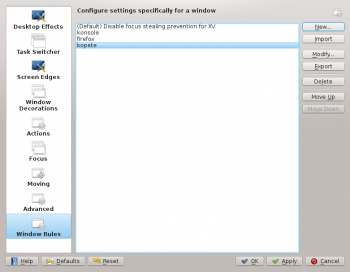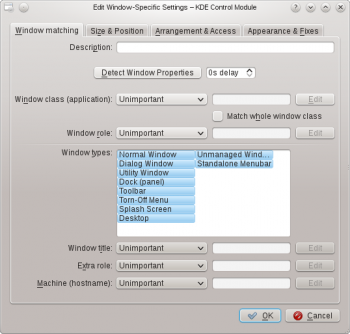KWin Rules: Difference between revisions
| Line 17: | Line 17: | ||
===Invoking the Editor=== | ===Invoking the Editor=== | ||
There are several ways one can invoke the | There are several ways one can invoke the ules editor. Below are a couple: | ||
* Right-click on the title-bar of any window, choose <menuchoice>Configure Window Behavior ...</menuchoice> and in the '''Configure''' window, select <menuchoice>Window Rules</menuchoice> or | * Right-click on the title-bar of any window, choose <menuchoice>Configure Window Behavior ...</menuchoice> and in the '''Configure''' window, select <menuchoice>Window Rules</menuchoice> or | ||
Revision as of 14:10, 2 March 2012
Overview
KWin allows the end-user to define rules to alter the behavior of an application's windows attributes.
For example, when an application is started, it can be forced to always run on Virtual Desktop 2. Or a defect in an application can be worked-around by using a rule to, say, always force the window on top of all others.
This document provides working examples along with detail information about the KWin Rule Editor functionality.
Examples
A collection of examples is provided to convey the power of KWin window rules.
KWin Rule Editor

Invoking the Editor
There are several ways one can invoke the ules editor. Below are a couple:
- Right-click on the title-bar of any window, choose and in the Configure window, select or
Anatomy

The editor is composed of four tabs:
As the name implies, is used to specify criteria to match one or more windows. The other three tabs are used to alter the characteristics of the matching windows.
Rule Evaluation
When an application starts (or the rules are modified), KWin evaluates the rules from the top of the list until either a matching rule is found or the list is exhausted. If a rule matches, the attributes set in the rule are applied to the window and the window is displayed.
Window Matching
Each window rule has user-specified Window Matching criteria. KWin uses the information to determine whether the rule is applicable.
Window Attributes
Along with Window Matching criteria, each window rule has a set of Window Attributes. The attributes override the corresponding application's settings and are applied before the window is displayed by KWin.

